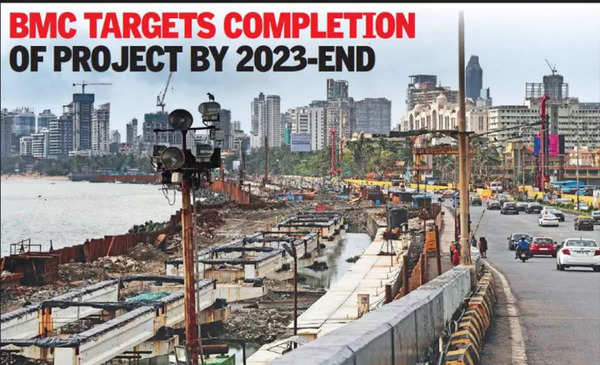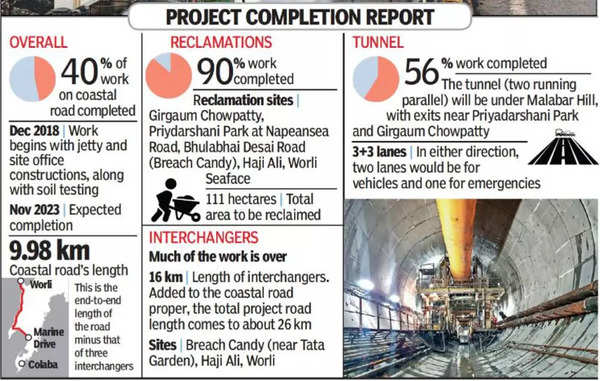Mumbai is currently undertaking an ambitious coastal road project, which, once completed, will add an 8.5 km long and 20-metre wide sea promenade to the city between Priyadarshini Park at Napean Sea Road, and the Worli side of the Bandra Worli Sea Link. The Brihanmumbai Municipal Corporation (BMC) stated that in March 2022 that the project would be completed by the predicted deadline of November 2023.
The project involves the reclamation of 111 hectares of land – 63.6 per cent of the space or about 70 hectares are meant to be used as recreation spaces and amenities. 13.6 per cent will be used for the construction of the sea wall to protect the area from sea waves, and 23.88 per cent will be for the construction of interchanges for the project. Gardens will be developed on the land, as well as seating for tourists, cycle paths, public toilets, a butterfly garden, and a biodiversity park to the city, along with an underground parking lot with a capacity to accommodate 1,864 vehicles.

However, while the project claims to revitalise green spaces and divert the pressure of the traffic in the city, architects, urban planners, and environmentalists have questioned the viability of this revitalisation plan for the economy of Mumbai’s western coastline. They have expressed concerns that this project would restrict access to the seafront ,as well as act as a visual barrier for people looking out at the sea.
Most importantly, serious environmental concerns have been raised as well. The project ignores the eco-sensitive nature of the intertidal zones. The construction activities, and land refilling, all damage fragile coastal ecosystems. Coral reefs and crucial fish spawning sites are feared to be destroyed, and marine food chains are likely to be disrupted. Mumbai is already prone to flooding during the monsoons, and the project creates a dam and threatens existing natural storm water drainage patterns, increasing the risks of flooding.
The project aims to decongest Mumbai’s roads and reduce commute time. However, there might be fundamental issues with this line of reasoning. Research has observed correlations between increase in road capacity and traffic. This is related to the concept of induced demand in economics, where increasing the supply of a product can make people want it even more. The building of new roads incentivises people to use personal vehicles more and increases their commute time. Moreover, this emphasis on roads to support the use of private transport, makes more people reliant on them. New roads create new drivers and the intensity of traffic goes up
Land reclamation is especially concerning, considering rapid climate change across the world and rising sea levels, threatening the already vulnerable infrastructure of the city. The rapid changes in the seashore risk the safety of the entire city to the vagaries of climate change, contributing to greater environmental damage.
The disruption in the marine environment adversely affects the local fishing communities and their livelihood. Even now, the vibrations from the drilling and land refill have driven fish away, forcing fisherfolk to seek deeper waters. Their commute time increases and rising fuel prices deepen the economic strains they face. Moreover, the pillars constructed present as hazardous to their safety, obstructing their fishing route.
It was on September 25, 2018, that the project was given approval by the BMC’s standing committee. The work commenced almost immediately, and would have progressed considerably. But a court stay in 2019, and the pandemic have delayed execution, according to officials.
Also read: What Is Greenwashing?: Unpacking False Marketing Claims About Environmental Sustainability

Wind and water patterns determine navigation, risking the possibility of crashing into the pillars, especially during storms. Fisherfolk, facing the loss of their livelihood, have been forced to seek other alternative sources of income, such as daily wage labour or domestic work. Currently, no concrete plan to address the concerns and disruptions of employment of fishing communities has been announced or implemented.
This also raises concerns about who the project benefits. It caters to a certain section of society, that is, those who travel by car, connecting the more affluent neighborhoods in the city. The majority of the population in the city commute via walking or public transport. A report by Mumbai Vikas Samiti, a forum of transport experts, observed that 77.1 percent of daily passenger trips in the city in 2015-16 were by public transport and only 22.9 percent by private vehicles.
The local trains are considered the lifeline of the city, and major disruptions such as flooding impede the city’s daily activities, emphasising their necessity. Most of the people in the city do not benefit from the coastal road, which targets more affluent households and upholds their interests. The project seems to emphasise development for a few, at the cost of vulnerable and marginalised communities.
while the construction of the new coastal road may decongest traffic briefly, traffic intensity might increase in the long term, negating the purpose of building such roads. Instead, more investments should be diverted to public transportation systems, to increase their efficiency and accessibility. More buses, with greater frequencies, for example, incentivises their use over private vehicles, and eases congestion. The city should be made more walkable and an increase in bicycle routes can incentivise their use, as well improve road safety
The project aims to decongest Mumbai’s roads and reduce commute time. However, there might be fundamental issues with this line of reasoning. Research has observed correlations between increase in road capacity and traffic. For example, studies on traffic congestion and highways in the U.have S found that for every 1 percent increase in highway capacity, traffic increases 0.29 to 1.1 percent in the long term (about five years out), and up to 0.68 percent in the short term (one or two years).
This is related to the concept of induced demand in economics, where increasing the supply of a product can make people want it even more. The building of new roads incentivises people to use personal vehicles more and increases their commute time. Moreover, this emphasis on roads to support the use of private transport, makes more people reliant on them. New roads create new drivers and the intensity of traffic goes up.


Thus, while the construction of the new coastal road may decongest traffic briefly, traffic intensity might increase in the long term, negating the purpose of building such roads. Instead, more investments should be diverted to public transportation systems, to increase their efficiency and accessibility. More buses, with greater frequencies, for example, incentivises their use over private vehicles, and eases congestion. The city should be made more walkable and an increase in bicycle routes can incentivise their use, as well improve road safety.
The Mumbai coastal road project is an ambitious and extravagant project and can do more harm than good. Development goals need to be inclusive and cannot run roughshod over marginalised communities. The idea behind urban development needs to be questioned in the Indian context for true sustainability and accessibility.
Also read: Police Brutality And Environmental Movements: Remembering The Thoothukudi Massacre
Featured Image Source: The Wire
About the author(s)
Aradhana Choudhury is an aspiring policymaker. She is currently pursuing herMaster’s in International Development and is seeking to apply intersectional learningto development strategies. She has a keen interest in development research, policyanalysis, and gender. She hopes to support tangible impacts towards gender equalityand equity, with community participation at the forefront.Aradhana also has a keen interest in history and heritage studies and has worked toexpand the interest of general audiences in the history of a place




